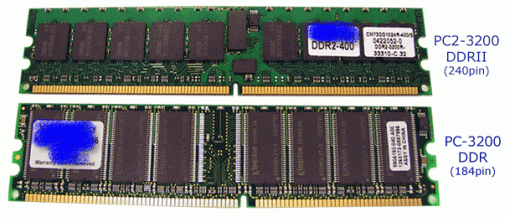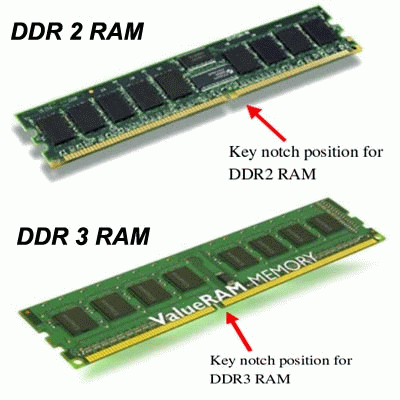|
"What is RAM ? Your Computer Temporary Storage Info Page"
|
||||||||||||||||||||||||||||||||||||||||||||||||||||||||||||||||
| Name | Number of Notches in Card Edge Connector | Usage |
|---|---|---|
| 30-pin SIMM (single inline memory module) | One | Desktop computers (most earlier 286, 386, 486, Pentium I) |
| 72-pin SIMM | One | EDO RAM in desktop computers (mostly Pentium I) |
| 168-pin DIMM (dual inline memory module) | Two | SDRAM in desktop computers (mostly Pentium II and III) |
| 184-pin DIMM | One | DDR SDRAM in desktop computers |
| 184-pin RIMM | Two | Rambus in desktop computers |
| 240-pin DIMM | One | DDR2 SDRAM in desktop computers |
| 240-pin DIMM | One | DDR3 SDRAM in desktop computers |
| 144-pin SODIMM (small outline dual inline memory module) | One | Notebook computers |
| 200-pin SODIMM | One | Notebook computers |
Note: The 30-pin SIMM already obsolete.
Each memory modules come in a confusing number of different physical sizes, speeds, and other characteristics. Below shows the relative sizes, shapes, and speed of several module types.
1) Types of 72 pins RAM
EDO (Extended Data Output) - Access Speed: 50, 60, 70 nanoseconds
FPM (Fast Page Mode) - Access Speed: 50, 60, 70 nanoseconds
2) Types of 168 pins RAM
SDRAM (Synchronous Dynamic RAM)
| Memory | Speed (MHz) | Max Bandwidth |
|---|---|---|
| PC 66 | 66 | 0.53 GB/second |
| PC 100 | 100 | 0.80 GB/second |
| PC 133 | 133 | 1.06 GB/second |
| PC 150 | 150 | 1.20 GB/second |
| PC 166 | 166 | 1.20 GB/second |
3) Types of 184 pins RAM
DDR (Double Data Rate) SDRAM
| Memory | Speed (MHz) | Max Bandwidth |
|---|---|---|
| PC2100 (DDR 266) | 133 | 2.13 GB/second |
| PC2700 (DDR 333) | 166 | 2.66 GB/second |
| PC3200 (DDR 400) | 200 | 3.20 GB/second |
Here are the graphical illustrations between DDR and DDR2 desktop RAM. You should notice the key notch positions of both types of RAM are in slightly different position.

4) Types of 240 pins RAM
DDR2 (Double Data Rate 2) SDRAM
DDR2 400 MHz (PC2-3200)
DDR2 533 MHz (PC2-4200)
DDR2 667 MHz (PC2-5400)
DDR2 800 MHz (PC2-6400)
DDR2 900 MHz (PC2-7200)
DDR2 1000 MHz (PC2-8000)
DDR2 1066 MHz (PC2-8500)
DDR2 1150 MHz (PC2-9200)
DDR2 1200 MHz (PC2-9600)
DDR3 (Double Data Rate 3) SDRAM
DDR3 1066 MHz (PC3-8500)
DDR3 1333 MHz (PC3-10600/10666)
DDR3 1375 MHz (PC3-11000)
DDR3 1600 MHz (PC3-12800)
DDR3 1625 MHz (PC3-13000)
DDR3 1800 MHz (PC3-14400)
DDR3 1866 MHz (PC3-15000)
DDR3 2000 MHz (PC3-16000)
Here are the graphical illustrations between DDR2 and DDR3 desktop RAM:

5) Types of 200 pins RAM
DDR PC2100 200-pin SODIMM (Small Outline DIMM)
DDR PC2700 200-pin SODIMM
DDR PC3200 200-pin SODIMM
DDR PC4200 200-pin SODIMM
DDR PC5300 200-pin SODIMM
As you can see, the RAM manufacturers is producing more and more advanced RAM in term of RAM capacity and speed. I hope this tutorial will answer your question on what is RAM, the RAM capacity and brand as well as different types of RAM.
Can't find what you're looking for? Try Google Search!

|
|
Other Computer Training Links:
- Discover the Secrets Behind the Windows Vista Program
- Free Step-by-step Microsoft Office 2003 and 2007 Courses
- The Complete Guide to Setting up Network at Home or Office
- Internet Courses - Getting All The Possible Resources That You Can
- Your Ultimate Computer Data Backup and Recovery Training Course
- All You Needs to Know About Computer Viruses, Spywares, Malwares, Trojans, Worms, etc...
Back to Top
You're viewing the What is RAM info page, click here to go back to the Home Page
Google Search:

Free Newsletter
Get your free subscription below to download two ebooks and improves your computer skills or click here for details.
Then why not use the button below, to add us to your favorite bookmarking service?
| FREE E-books | Office 2007 | Office 2003 | Internet & E-mailing | Sitemap |
Microsoft Windows 7, Vista, XP, Microsoft Office Word, Excel, PowerPoint,
and Outlook are either registered trademarks or trademarks of
Microsoft Corporation in the United States and/or other countries.
